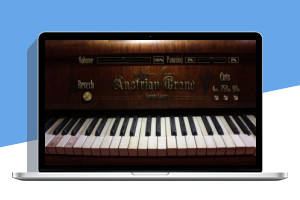
MAC AU x86 x64 – 2,03 GB | MAC VST x86 x64 – 2,03 GB | MAC AAX – 2,03 GB
WiN VST x86 x64 – 2,03 GB | WiN AAX – 2,04 GB
Adam Monroe的Austrian Grand钢琴是从100岁的Bruder Mikula Wien奥地利大钢琴中通过一对AEA R84带状麦克风采样到AEA TRP带状麦克风前置放大器中的。录制之前,先将钢琴的锤子毛毡打磨一下,以使它们变热。钢琴是用盖子下的立体声采样的,因为那是音色最好的地方。整个钢琴采样需要花费数周的时间,因为这种状态下大多数音栓都无法在任何时间段保持音高。钢琴经过了艰苦的采样,演奏的音色从最柔和到最响,形成了一个包含10个力度层和2个音符循环的库。
采样最初是通过录制另一对Oktava Mk-012来开始的,以捕获房间的氛围,但在早期就确定了带状麦克风可以最好地捕获钢琴的音调,并且有可能使样本库的大小增加几GB。包括室内麦克风不会明显改善声音。
为了获得色带特有的高增益信号噪声,在构建样本库时会出现大量噪声。色带产生的噪音可以忽略不计,但是当将30-40张钞票彼此叠放时(如在样品库中),噪音会变得非常明显。因此,采取了对样品进行消噪的额外步骤。不能完全消除噪音-为避免使样品库无菌-如果仔细聆听样品库,会听到微弱的“嘶嘶声”(类似于磁带嘶嘶声)。对于某些人来说,希望有一个小噪声,但是可以通过接合“ 4kHz cut”开关进一步降低它,因为这是大多数麦克风自噪声趋于传播的地方。
这款虚拟乐器可以很好地补充您的收藏,因为它填补了明亮的无菌钢琴(例如Yamaha的钢琴)和光滑而柔和的钢琴(例如Faziolis)之间的利基市场。我们很高兴能够为这样的旧钢琴采样,并将其变成一个独特的VST AAX音频单元插件。
亚当·梦露的奥地利大钢琴的Kontakt版本现已贬值(1/9/2020)。 VST,音频单元和AAX版本完全由我们编程。也是VSTi(虚拟仪器),音频单元(AU)或AAX插件的任何示例库中的目标都是尝试匹配Kontakt Player的性能。有了这个库,我们觉得我们已经做到了。
VST,AU和AAX版本包括更新的高性能算法,随着Adam Monroe Music发布的每台新虚拟乐器都在不断改进。例如,缓冲算法是双缓冲和多线程的,这意味着即使在速度较慢的计算机上,甚至在较低的延迟下,缓冲性能也很快。声音以纯净的C样式阵列进行保留和迭代。内存使用量与(已贬值的)Kontakt版本相当。由于具有稳定的VST /音频单元/ AAX代码库,因此您可以放心VST,AU和AAX单元版本将与Kontakt版本一样工作。
为什么要完全开发VST,音频单元或AAX版本?尽管Kontakt的完整版(功能强大,可以运行第3方样本库)价格昂贵(或者开发人员必须向Native Instrumetns支付许可费),但价格昂贵。从本质上讲,Kontakt是中间件。开发任何人都可以在任何DAW中使用的VST,音频单元和AAX版本并不会花费大量时间来开发钢琴样本库-大部分时间都花在了采样和处理样本上-因此,这真是轻而易举。
音频工程是创建VST,音频单元或AAX插件的很大一部分,但是这种三角钢琴的声音几乎未得到处理。某些中高频率会在钢琴的较低范围内回滚,并且样本会被降噪,但除此之外,该库几乎是100年历史奥地利大钢琴的声音的直接翻译。 。
该插件现在支持通过Catmull-Rom样条曲线的三次插值支持实时采样率转换。只要您使用44.1、48、88.2或96 kHz采样率,该插件就会自动检测您的采样率并相应地进行调整。
-16位音频样本
-2X轮循,10个速度层
-混响和降频
-5GB的样本数据
-支持44.1、48、88.2和96 kHz
Adam Monroe’s Austrian Grand piano was sampled from a 100 year old Bruder Mikula Wien Austrian grand through a pair of AEA R84 ribbon microphones into an AEA TRP ribbon microphone preamp. Prior to recording, the piano’s hammer felts were sanded down to warm them up a bit. The piano was sampled in stereo under the lid, because that’s where the tone sounded best. It took many weeks to sample the piano entirely, as it was in such a state that most of the tuning pegs could no longer hold a pitch for any length of time. The piano was sampled laboriously, with the softest to loudest dynamics being played, resulting in a library that includes 10 velocity layers and 2 note round-robin.
Sampling originally began by recording through an additional pair of Oktava Mk-012’s to capture room ambience, but early on it was determined that the piano’s tone was best captured by the ribbon mics, and that potentially increasing the size of the sample library by several gigabytes to include room mics would not significantly improve the sound.
Do to high-gain signal-noise unique to ribbons, quite a bit of noise was present when building the sample library. Noise from the ribbons is negligible, but when stacking 30-40 notes on top of each other – as in a sample library – the noise compounds and becomes quite noticeable. Therefore, the extra step of de-noising the samples was taken. Noise wasn’t removed completely – to avoid making the sample library sterile – and a faint “hiss” (similar to tape hiss) can be heard if you listen to the library carefully. For some people, a litte noise is desirable, but it can further be reduced by engaging the “4kHz cut” switch, as this is where most of the microphone self-noise tends to propagate.
This virtual instrument can be a great addition to your collection, as it fills a nice niche between bright sterile pianos (like Yamaha’s) and smooth, mellow pianos (like Faziolis). We were happy we could sample such an old piano and turn it into a unique VST AAX Audio Unit plugin.
The Kontakt version of Adam Monroe’s Austrian Grand Piano is now depreciated (1/9/2020). The VST, Audio Unit, and AAX versions are programmed entirely by us. The goal in any sample library that is also a VSTi (virtual instrument), Audio Unit (AU), or AAX plugin is to attempt to match the performance of the Kontakt Player. With this library, we feel like we have done just that.
The VST, AU, and AAX versions include updated, high-performance algorithms that have been improving with each new virtual instrument released by Adam Monroe Music. For example, the buffering algorithm is double-buffered and multithreaded, which means that buffering performance is fast, even on slower computers, and even in lower latencies. Voices are held and iterated over in a pure, C-Style array. Memory use is comparable to the (depreciated) Kontakt version. Because of the solid VST/Audio Unit/AAX code base, you can feel confident that the VST, AU, and AAX Unit versions will work just as well as the Kontakt version.
Why develop a VST, Audio Unit, or AAX version at all? Although a great piece of software, the Full version of Kontakt (required to run 3rd party sample libraries) is expensive (or the developer has to pay a licensing fee to Native Instrumetns). And essentially, Kontakt is middleware. Developing VST, Audio Unit, and AAX versions that anyone can use in any DAW does not add significant time to the development of a piano sample library – most of the time is spent sampling and processing the samples – so it’s a real no-brainer.
Audio engineering is a large part of creating a VST, Audio Unit, or AAX plugin, but the sounds of this grand piano have barely been processed. A little of the mid and high frequencies were rolled back in the piano’s lower range, and the samples were de-noised, but other than that, this library is nearly a direct translation of the sound of a 100-year-old Austrian Grand Piano.
This plugin now supports real-time sample rate conversion via cubic interpolation with Catmull-Rom splines. As long as you are using a 44.1, 48, 88.2, or 96 kHz sample rate, the plugin will automatically detect your sample rate and adjust itself accordingly.
– 16-Bit Audio Samples
– 2X Round-Robin, 10 Velocity Layers
– Reverb and Frequency Cuts
– 5GB of Sample Data
– Supports 44.1, 48, 88.2, and 96 kHz
